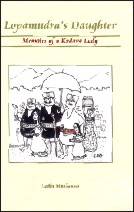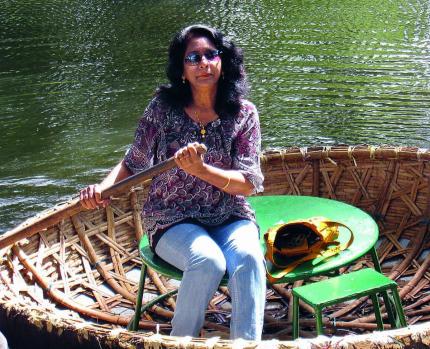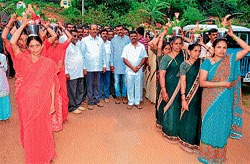By Dr. K. Javeed Nayeem, MD

My association with the Kodavas, the people from the hilly neighbourhood district of Coorg, now Kodagu, is almost as old as I am. Ever since my early childhood we have had Kodava managers and writers in our coffee plantation in distant Chickmagalur. Their choice as overseers of our coffee growing enterprise was a natural one as they are themselves age-old coffee growers, with the art simply running in their blood. Two of them who grew very close to me as I grew up were P. M. Pemmaiah and K. K. Ganapathy both of whom joined duty within days of one another, even as they themselves were both young lads, barely out of their teens.
While the former, an absolute teetotaler, with a very quiet temperament, retired after many decades of faithful service and left to look after his own family holdings, the latter, a hard-drinking meat-eater and boisterous merry-maker but no less faithful, somehow retired into an ashram, becoming a sanyasi of sorts, completely shunning liquor, his first love and becoming a total vegetarian. During the daytime they would teach me to use a catapult with deadly effect and also to speak their native dialect Kodava thakk. In the even-ings they would feed me with interesting nuggets from the fascinating folklore of Coorg and spell-binding stories of the valour of the Kodavas, a warrior tribe.
When I arrived in Mysore to commence my education, at the turn of the sixth decade of the last century, this smattering knowledge of Kodava thakk and the folklore of Kodagu,stood me in good stead in my interaction with the many Kodava boys and girls who happened to become my schoolmates. Many of them continue to be my closest friends even to this day. With good English schools being very scarce in all the Malnad districts, it was then common for most children from well to do families to be put in schools either in Mysore, Bangalore or Ooty.
While I then used my Kodava thakk only to impress the girls in my school, as some of them might still remember, or at least recollect as they read this, I now use it only in elusive bits and pieces, thanks to a lack of practice, only to converse with my most elderly Kodava patients. I do this, not to impress them, because they are long past their impressionable ages but only to calm and reassure them as the bondage that the use of any language establishes with its speakers is instant nd very strong.
There are not many books, at least in English, about Kodagu and the Kodavas themselves and I have read almost all those that exist, including some of the ones that are now out of print. While all of them are very interesting and informative, I think none of them can make up for what I just finished reading just two days ago. It is a book that is unfortunately not yet available in print but one which I hope will soon find a ready publisher and many readers consequently.
Authored by Dr. Latha Muthanna, a close friend and a fellow physician, who is settled in Mysore, it is a first person narrative in the words of her recently deceased mother Malavanda (Biddanda) Gowramma Achaiah, a well-known social worker who was born in the year 1920 and who spent much of her married life in and around Chickmagalur. It was first written by her in Kannada script in Kodava thakk which lacks a script of its own and later expanded and rendered into English by the daughter who seems no less of a writer or historian herself.
Written in a style and language which I never knew my friend was capable of, despite our close friendship (and intense professional rivalry) over more than thirty years, the book is immensely readable with an ample sprinkling of humour and is therefore ‘unputdownable.’ It has a very apt and fitting title: Lopamudra’s Daughter, with Lopamudra being one of the main tributaries of the Cauvery, a river which we all know is holy to most Hindus in general and the Kodavas in particular.
While the book deals mostly with the lives of a cluster of close relatives from a few families of Kodagu spanning over four generations, it throws much light on many little known but very significant nuggets from the history and folklore of the land and its people. That is what is likely to make it very unique and also perhaps render it a keepsake for anyone interested in the history of Coorg or simply in a bygone era. To the uninitiated however, keeping track of the various protagonists in the narrative, especially with their tongue-twisting family names, may seem a slightly daunting task.
While the book has interesting cartoons by the well-known Kodava cartoonist Ponnappa,I feel the final print edition would do well with some photographs related to the many places that find a mention therein. The visit of Gandhiji to Coorg and his impact on the freedom movement there, the travails of the ordinary women who would without exception unfailingly turn into extraordi- nary home-makers immediately upon exchanging marriage vows, the poignant and recurrent tragedies brought on by the lack of health care facilities in a land tormented by rain and storm for a greater part of the year, are all there in vivid detail to stir the feeling heart.
Since I also happen to be from the Malnad hinterland where life is not very dissimilar from what it is in Coorg I could instantly recapitulate, visualise, smell and even taste the sights, smells and tastes that the writer talks about when she describes the traditions, the weddings, the festivals, or even the seasonal delicacies like mushrooms, honey and bamboo shoots, that come and go with different times of the year.
Reading the book was like finding the key that suddenly unlocked the door of nostalgia to my own past and childhood. I am sure it will do the same to the others who happen to read it too.
source: http://www.StarofMhysore.com / Feature Articles / September 21st, 2012




